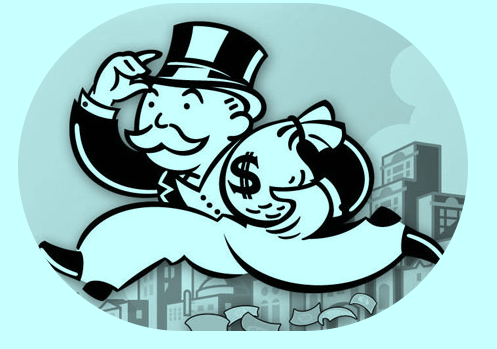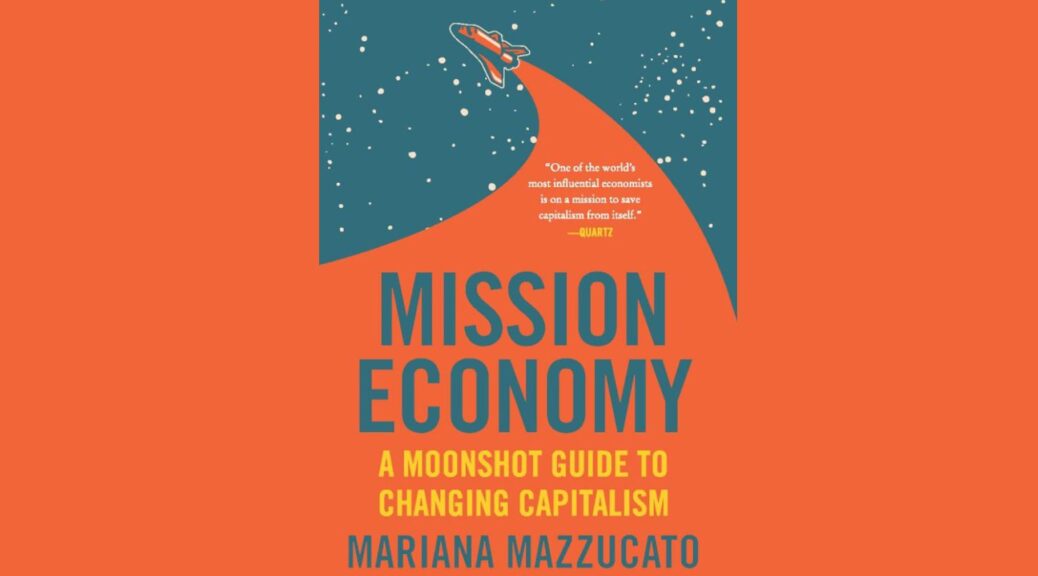The following is a thought piece based on Mariana Mazzucato’s newest book “Mission Economy: A Moonshot Guide to Changing Capitalism”. I blend her ideas with my own, but give her all the credit for what’s below.
Introduction:
Our world is in need of some serious change.
We’ve spent the past five decades being told that governments should get out of the way, but as a result, we’ve hollowed out the core of the public sector. We’ve stripped bare the entities that serve the public interest over private profit. Our greatest risk is that we will continue to stand by idly while the current trajectories persist: growing financial inequality, more uncapped carbon emissions, systemic and intentional discrimination, widening identity polarization. If we don’t turn these four horses of the apocalypse around, we’re headed for somewhere between Mad Max and The Hunger Games. How did we get here? What can we do? Who should take the lead?
Political Economist Mariana Mazzucato recently released a brilliant book on reshaping capitalism through a more inspirational and empowered public sector. She argues that:
a) There’s a burning platform: Capitalism is in crisis
b) We drank the neoliberal kool-aid: Or, the myth that governments should stay out of markets
c) We can rise above: Governments must be the ones to inspire change through bold and decisive missions (i.e. the Moon Landing)
Below are a blend of ideas and quotes from Dr. Muzzacato mixed in with my own commentary. Please reach out if agree, disagree, or want to dive deeper on any of these ideas.
There has been incisive criticism of Mazzucato which is that she is a) an academic, b) an economist (social science is notoriously complex and counter-arguments are easily found), c) she has never ran a business, started a company or really innovated herself so what does she actually know about it…….but still her message is inspiring and it resonates.

—
A) Four Reasons Why Capitalism is in crisis
“Human activity is eroding the conditions necessary for social and environmental stability.”

1. Finance is only financing FIRE (finance, insurance, real estate).
· Global finance has become a bit of a castles-in-the-sky scheme, according to Mazzucato. 80% of financing goes back into financial firms, while manufacturing, agriculture, technology, and public services suffer. The process of price discovery and allocating scarce capital, has gotten to a point where it is too self-serving. FIRE profits are private, FIRE losses are public (a moral hazard). This destroys the incentive to innovate.
· This current structure fuels a debt-driven system and speculative bubbles that, when they burst, bring banks and others begging for government bailouts.

2. Business is focusing on quarterly returns.
· Over the past decade, 52% of the S&P 500’s net income was handed to shareholders in buybacks, and 39% of net income was handed to shareholders in dividends (that’s 91% of profits!). Rather than investing in Capital Expenditures (i.e., plants, equipment), R&D, worker training, wages, or communities…profits go to capital owners. Only 9% of returns are invested in the future.
· According to legendary GE CEO Jack Welch, “Shareholder value is a result, not a strategy…your main constituencies are your customers, your employees, and your products.” He wouldn’t last a week on present-day Bay Street.
· Most CEOs don’t have the courage to break from their quarterly earnings cycle and dedicate their strategy towards a long-term horizon (>1 year). Their boards don’t have the courage to direct them to do otherwise.

3. The planet is warming.
· If we don’t reverse our industrial policies in the next ten years, our climate breakdown will be irreversible. We’re trending for 3+ degrees Celsius, and the Global North is starting to experience what the Global South has been living with for years (i.e., wildfires and floods).
· Our economic system is set-up to propagate this trend: fossil fuels dominate our energy sources, industries are too carbon-intensive, the financial sector has fed the fossil-fuel driven economy, government is nurturing this dysfunctionality. Wholesale change is needed.

4. Governments are presiding, not leading.
· Governments have bought into the ideology that their role is simply to fix problems (i.e., market failures), not achieve bold objectives. Says who?
· Governments create and shape markets through: investment in areas like education, research, and physical infrastructure; demand generation via procurement; legal codes; and anti-trust policies. They even print the money that flows through markets. There are no markets without governments.
· Governments need to use their central role and resources to rethink corporate governance in order to broaden the range of stakeholders valued by capitalism.
—

B) Five Myths About Governments that we have all decided to believe
“Since the 1980s, a mindset of aversion to risk has filled civil servants with the fear of doing anything more than facilitating the private sector.”

Myth 1: Businesses create value and take risks; governments only de-risk and facilitate.
· It’s governments that actually make the riskiest bets, with the highest uncertainty, at the largest scales. Government bodies created the internet (DARPA, CERN), the GPS (US Navy), Siri (DARPA), and touch-screen display (CIA).
· Public institutions have lost the confidence to act and are failing to invest in their own capabilities: strategic management, decision science, and organizational behaviour.
· Decades of privatization and outsourcing have led to high costs, poor service, and the capture of government contracts by a small number of firms—billions of dollars going to consultants with little skin in the game.

Myth 2: The purpose of government is to fix market failures.
· Market failure theory (MFT), evolved from microeconomics, argues governments should only intervene when markets break down (i.e. positive externalities, negative externalities, information asymmetries). Under this theory, however, markets are in perpetual failure and governments should always be intervening.
· Public choice theory (1960s) pushed this idea further and said that government failures are worse than market failures. They assumed that policymakers and bureaucrats were purely self-interested and prone to corruption and ineptitude. How Hobbesian.
· But government spending doesn’t crowd-out investment, it crowds it in. It creates spaces for innovation and collaboration between parties that would never occur in pure competition. It takes risks that businesses never would, driving the world forward.

Myth 3: Government needs to run like a business.
· New Public Management (NPM) arose in the 1980s in business schools to suggest that there should be a profit-motive involved in government to make it more efficient. It caught on during the Thatcher-Reagan-Mulroney years and spread across the globe in the 1990s.
· NPM led to deregulation (encouraging risky behaviour), shareholder value (enriching executives at the expense of long-term investment); and outsourcing (leading to loss of public control over the quality of services and products). But at least it made some shareholders richer.
· NPM assumed that the public sector suffers from a principal (citizens) – agent (bureaucrats) problem: citizens can’t hold the public sector accountable the way shareholders can a corporation. But besides voting, the public sector is often held to a much higher standard than the private sector.

Myth 4: Outsourcing saves taxpayer money and lowers risk
· The gutting of the public sector over the past five decades has led to management and IT consulting firms taking over increasingly larger roles of developed governments. The problem is, they often suck at it, and they cost 1.83x more than experienced civil servants (in the US).
· In the UK, the National Accounting Office estimates that a typical project with PFI (public-finance, private delivery) is 40% more expensive than if done in house. Consultants suffer from a worse principal-agent problem than civil servants: they serve profit, not citizens, and are incentivized to drag out engagements (see Phoenix Pay System).
· This trend has encouraged developing countries (pushed by the World Bank and IMF) to privatize and outsource key services (i.e., waste collection, school meals, building maintenance, prisons, and even ambulance and probation services). All while economists and political leaders continue to push for smaller governments and balanced budgets.

Myth 5: Governments shouldn’t pick winners.
· A government that lacks imagination will find it more difficult to create public value.
· Industrial policy is the policy of picking winners. Policymakers need to make decisions, and of course, they must pick things. Their choices could include seizing technological lead in a sector, diffusing knowledge, creating jobs, raising productivity and incomes, boosting regional development, and defence.
· The real problem is the practice of socializing risks and privatizing rewards. The same year the US government made the $535M guaranteed loan to Solyndra, it made a similar loan of $465M to Tesla—now a global leader. Somehow the $4.9B in government loans received by Elon Musk’s three companies is left out of his narrative as a daring entrepreneur.
—

C) Governments must take a “missions” approach to solving society’s grand challenges
So what do we do about it? Muzzacato dedicates the second half of her book to this question. First she uses the Moon-landing as an example of an inspiring “mission”, which not only rallied the public and private sectors to achieve a historic feat, but also inspired innovation and invention that spilled over into countless markets, benefiting all of society (i.e. camera phones, athletic shoes, foil blankets, dust busters, baby formula, wireless headsets, artificial limbs, computer mice, portable computers, freeze-dried food, CAT scans, smoke detectors). Second, she asks us to “aim higher” by selecting ambitious and inspiring missions for our society to tackle, led by governments, such as implementing a Green New Deal, innovating for accessible healthcare, and narrowing the digital divide. Finally, she concludes with seven principles for the New Political Economy, summarized below.

Seven Principles for the New Political Economy
“Real progress will only happen when stakeholder governance and ‘purpose’ become central to how organizations are governed and how they interact.”

1. Value: collectively created
· Our dominant economic framework rests on the assumption that people maximize their own preferences. This is not always true (i.e., Prospect Theory). We must believe in the value of public purpose and its ability to serve the public interest. This starts with openly caring about more than our individual interests: the term “idiot” comes from Greek, meaning “someone who does not operate in the public sphere”. Are you an idiot?
· Public goods are worth more than their costs. They have “multiplier effect” impacts that echo through society.
· We need business, government, and civil society to create value together, with none being relegated to cheerleaders of the other.

2. Markets: shaping not fixing
· According to Market Failure Theory, governments should only step in to correct market failures: positive externalites (under-investment by private sector—basic research), negative externalities (pollution—carbon taxes); asymmetric information—(banks’ risk appetite—loans to SMEs). But MFT also operates under the assumption that markets are perfectly competitive. They are not.
· Governments must actively “co-create and co-shape” markets. They must go from market fixing to market shaping; being proactive rather than reactive. Markets are dynamic, even if economists believe they operate in a vacuum.

3. Organizations: dynamic capabilities
· A theory of innovation needs to be nested in a theory of learning, experimentation, and adaptation to uncertainty. Learning by doing is a key element in improving an organization’s fitness and developing “absorptive capacity”. This must be adopted in the public sector. Its okay to take risks.
· Public organizations must find new ways to create and implement strategic actions (i.e., leadership capabilities, engaging with groups), rethink how civil service is developed (i.e. training, performance assessment, promotion), and re-imagine how work in public organization is managed (i.e., cross-sectoral, iterative).

4. Finances: outcomes-based budgeting
· The “urgency to win” means funding is always available for wartime missions and crises. There is no reason why the “whatever it takes” mentality cannot be used for social problems. What if budgets were based on outcomes to be reached instead of haphazard cost-benefit analyses?
· Public sector deficit is private sector surplus. National debt, which so exercises many politicians and citizens, is actually the historical accumulation of money spent by government, not taxed back, and now a privately held asset. Government red ink equals private-sector black ink. Debt is okay.
· Government spending only runs into problems (i.e., inflation) when there’s no growth in the economy. Financial institutions are the last place it should go. Instead, some key factors that increase productivity include education, research, science-industry linkages, worker training, and patient (long-term) financing.

5. Distribution: sharing risks and rewards
· Wealth is created socially: all inventions stand on the shoulders of giants, which likely stood on the backs of public sector investment. We must move from redistribution to predistribution: collective ownership structures, government equity in companies (preferred shares), and stable employment.
· Government loan guarantees and bailouts should have more conditionality. Public risk and private profits erodes faith in government capabilities.

6. Partnership: purpose and stakeholder value
· The notion of “purpose” and stakeholder value is not only about changes to corporate governance but is also about the details of contracts between business and the state.
· Stakeholder value means weighing the importance of workers, communities, and environments alongside shareholders. In Scandinavia, trade union members sit on boards to help steer investments and remuneration. Meanwhile in Canada, nearly all corporate entities have busted up their worker unions. No wonder >50% of jobs are part-time or contract.

7. Participation: open systems to co-design our future
· Mass publics are deserting the old-line, oligarchical political organizations that mobilized them in the modernization era—but they are becoming more active in a wide range of elite-challenging forms of political actions (a renaissance of democratic engagement).
· New decentralized forums are needed that bring together different voices and experiences, such as citizen assemblies.
Guest blog post by Drury

